After 4 days of climbing up and down the mountains along the Inca Trail, we were finally standing at Sun Gate. Excitement was high. And then slowly, the rising sun began to shine on the magical site of Machu Picchu.
Ollantaytambo
The important Inca site of Ollantaytambo (Ollanta) is in the heart of The Sacred Valley. Since it is on the drive from Cusco to Machu Picchu many people make a quick stop here on their way to or from the Inca site. We visited it as a day trip from Cusco so we could have more time at this interesting place.
The steep river valleys of the Urubamba and Patakancha Rivers are covered in agriculture terraces. Because the area is very dry, the Incas built cisterns and elaborate irrigation canals throughout these terraces. At the top, 200 steps above Ollanta, are the remains of an Inca ceremonial centre and fortres.
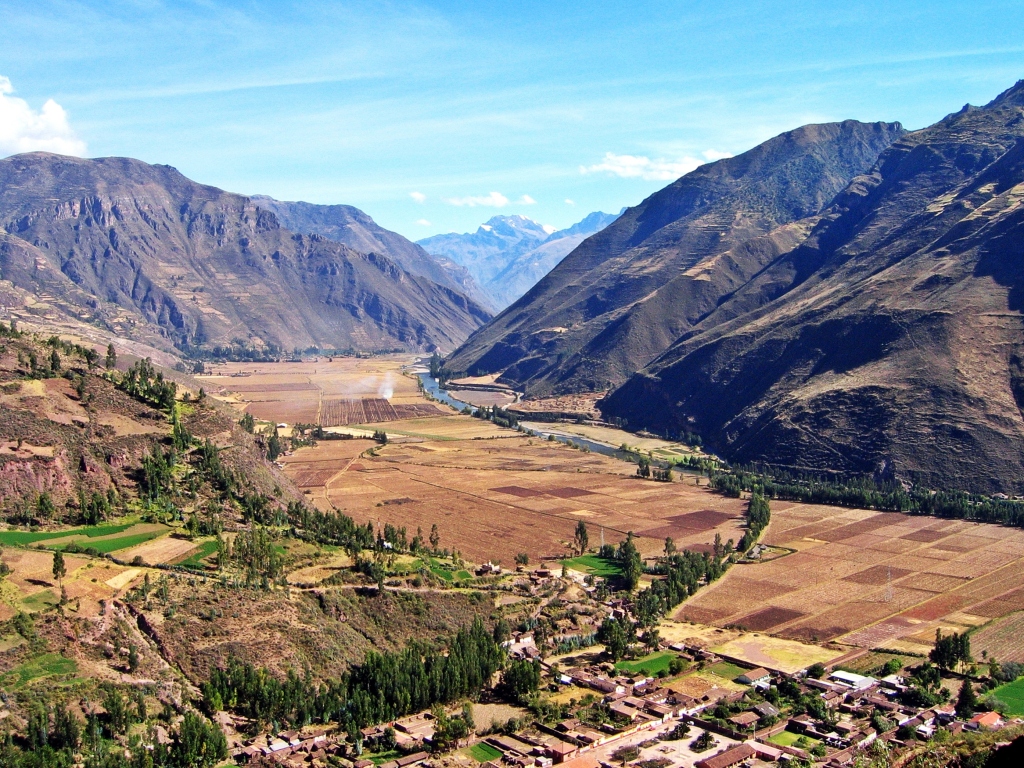
Sacred Valley, Peru 
Terraces of Ollantaytambo, Peru 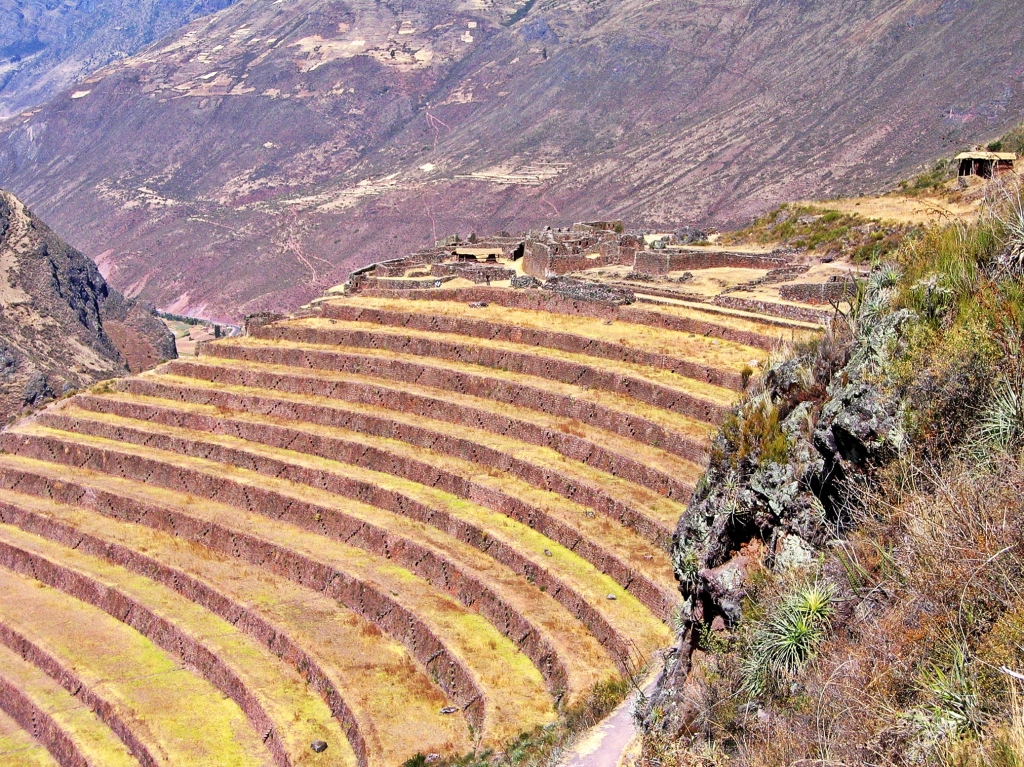
Ollantaytambo, Peru 
Ollantaytambo, Peru 
Terraces, Ollantaytambo, Peru 
Fountain, Ollantaytambo, Peru
The most interesting part of Ollanta though is what’s across the Patakancha River. On the rock face of Mount Pinculluna are stone storehouses where the Inca stored their crops. The higher elevation meant stronger winds and lower temperatures so the food wouldn’t spoil. Also on the cliff you can see the large face of Wiracocha, the Inca god who created the sun and the moon.

Store houses and Wiracocha god, Ollantaytambo, Peru 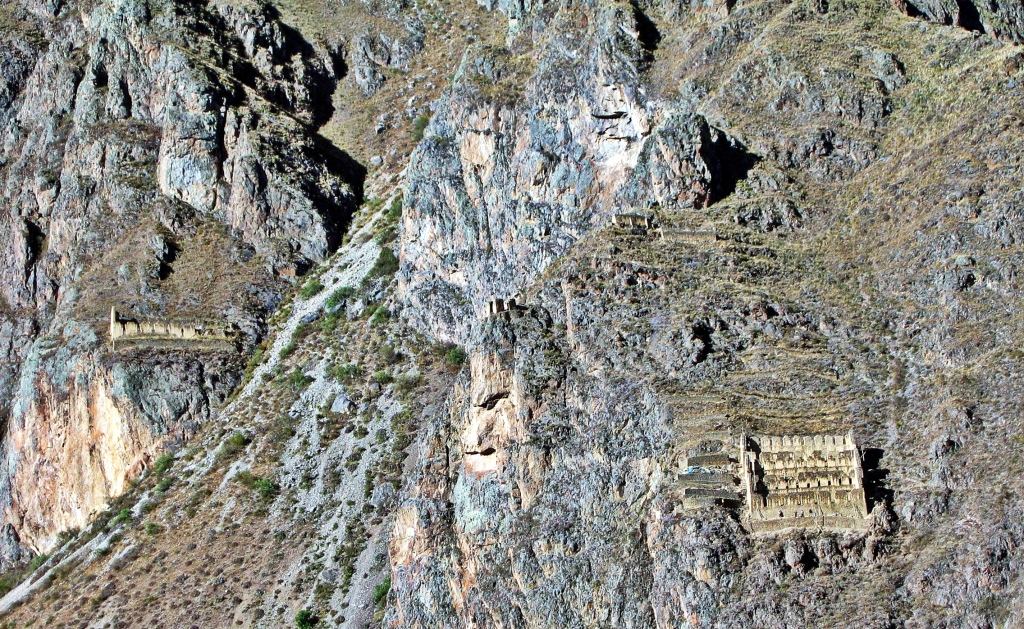
Store houses and Wiracocha god, Ollantaytambo, Peru 
Store houses, Ollantaytambo, Peru
The Inca Trail
There are a few different ways to get to Machu Picchu. We chose to hike the Classic Inca Trail. It’s a multi-day hike in the Sacred Valley passing many Inca ruins. Portions of the hike follow roads that the Inca’s built centuries ago connecting various Inca settlements including the incredible Machu Picchu.
Day 1 – 620 m ascent, 12 km, 6 – 7 hours
We began our trek in Piscacucho (2,680 m) on the side of the Urubamba River. Anticipation was high in our group of 16 trekkers. Not long into the first day we started to climb and were rewarded with awesome views of the Urumbamba River Valley. The dry environment gives interesting vegetation like flowering cacti and scrub grasses.
Walking further we saw our first Inca ruin on the trek, Llactapata and its garden terraces. Archaeologists believe it was a rest stop for travelers going to Machu Picchu. We were to pass by a few more Inca villages over the next three days which is part of the draw for this classic trek.
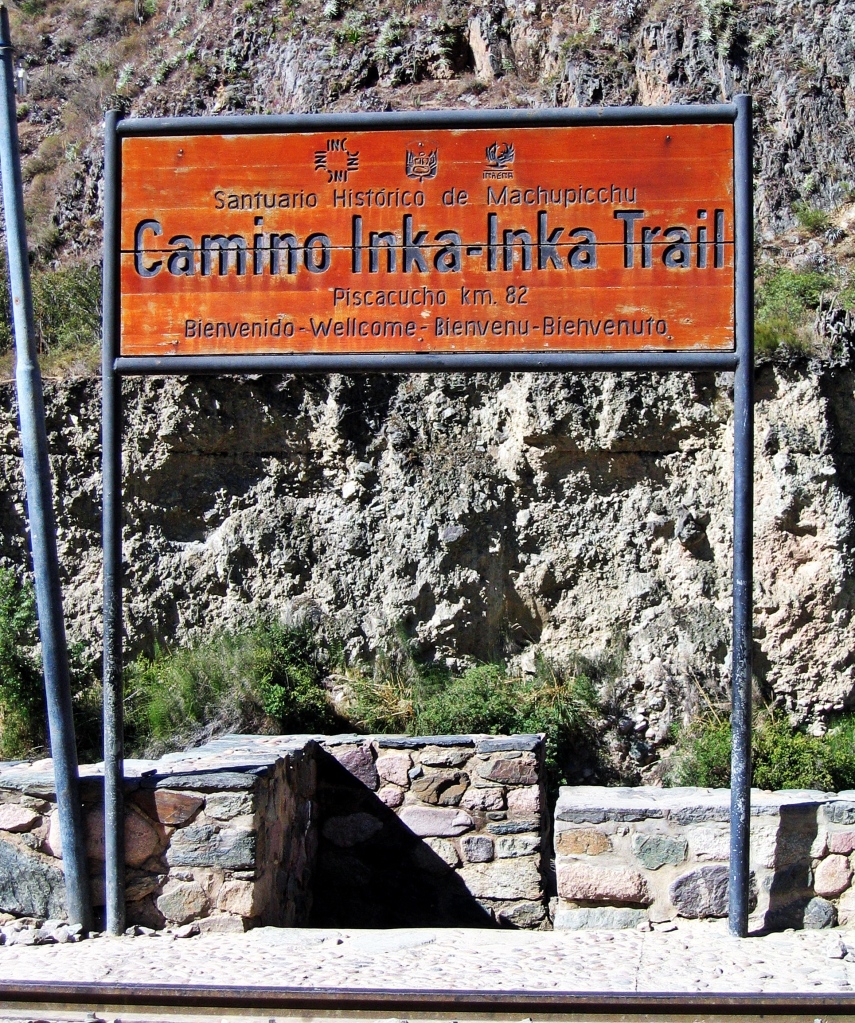
Start of the Inca Trail 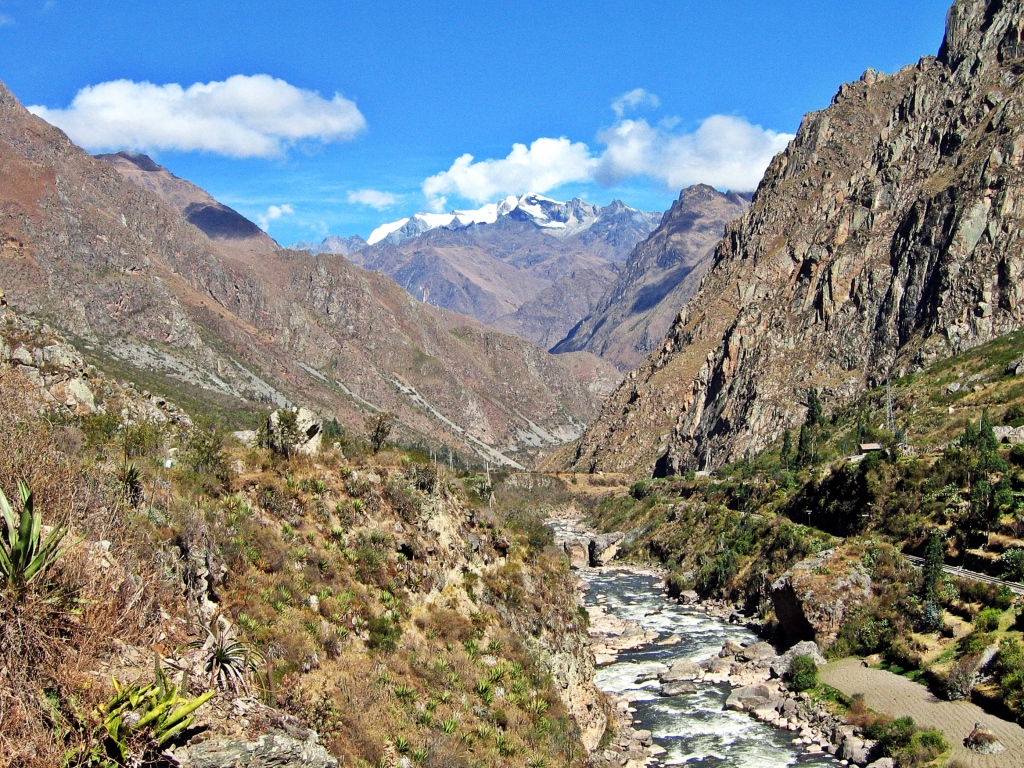
Urubamba River, Inca Trail 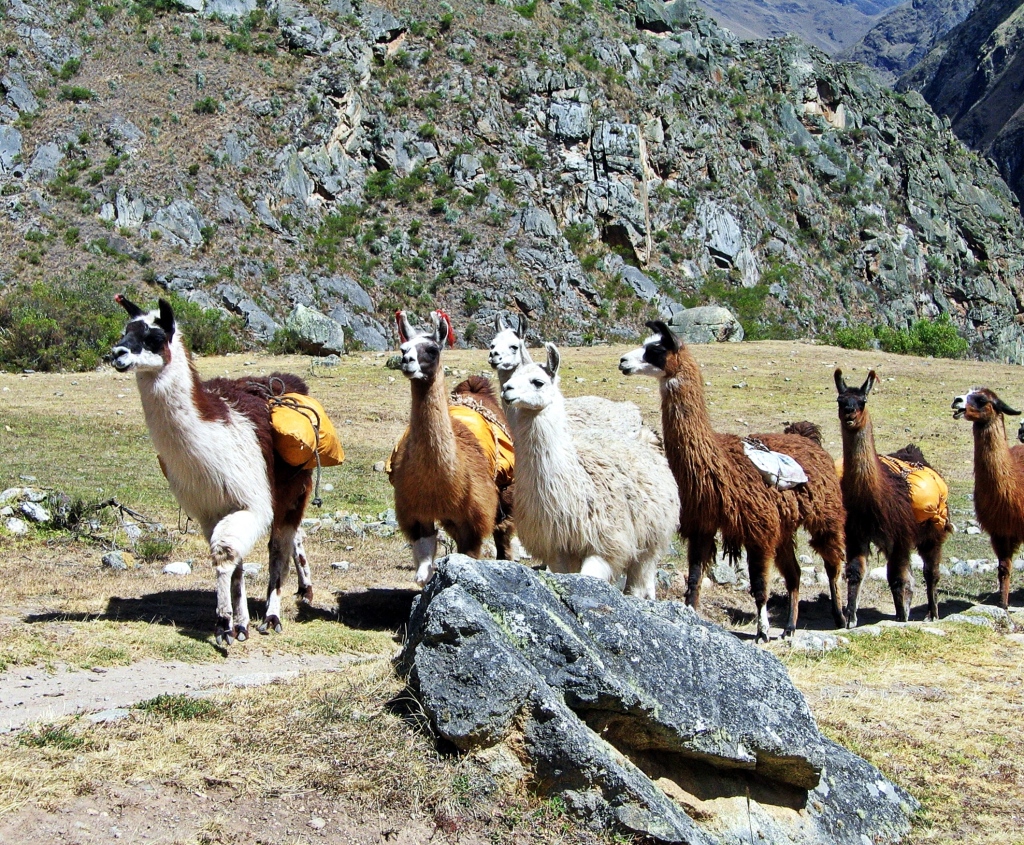
Llamas, Inca Trail 
Urubamba River, Inca Trail 
Flowering cactus, Inca Trail 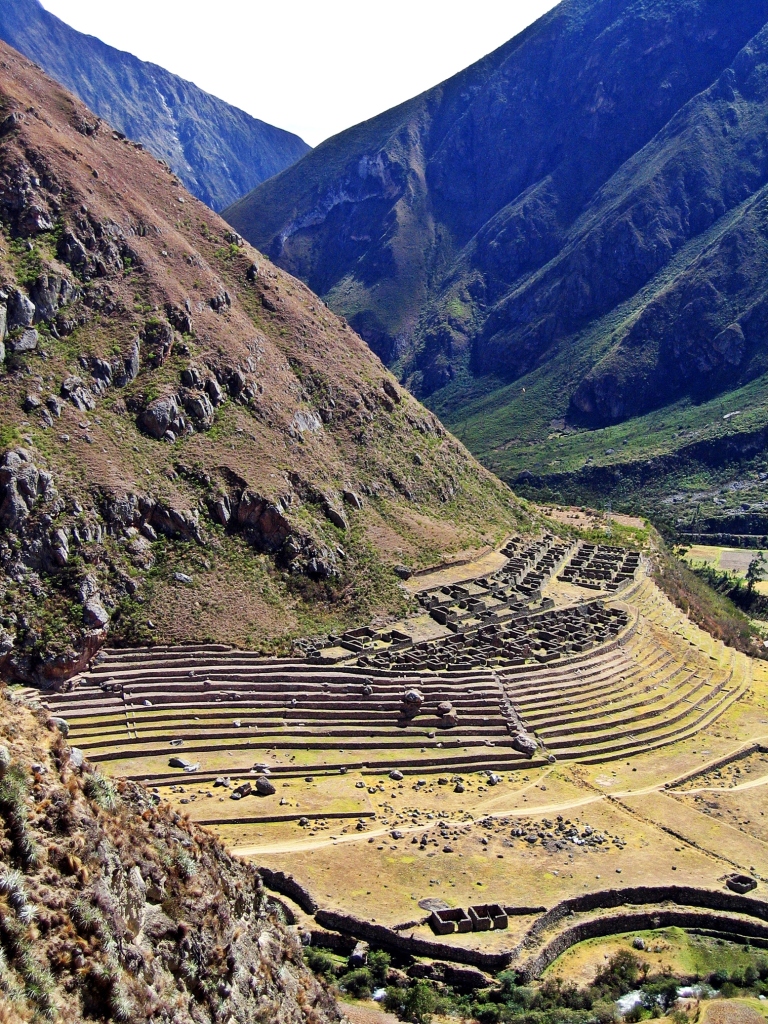
Llactapata, Inca Trail
Day 2 – 1500 m ascent, 16 km, 7 – 8 hours
The second day had the most elevation gain as we were to climb up and over two high mountain passes. Many parts of the Inca trail used the original Inca stone steps. It was incredible to think that is trail was made centuries ago and our feet are still using it today. Like many ancient steps we’ve taken, the riser heights are not consistent making it difficult to maintain a rhythm going both up and down.
In the low valleys we were surrounded by dense vegetation including the gnarled queuña trees and colourful flowers.
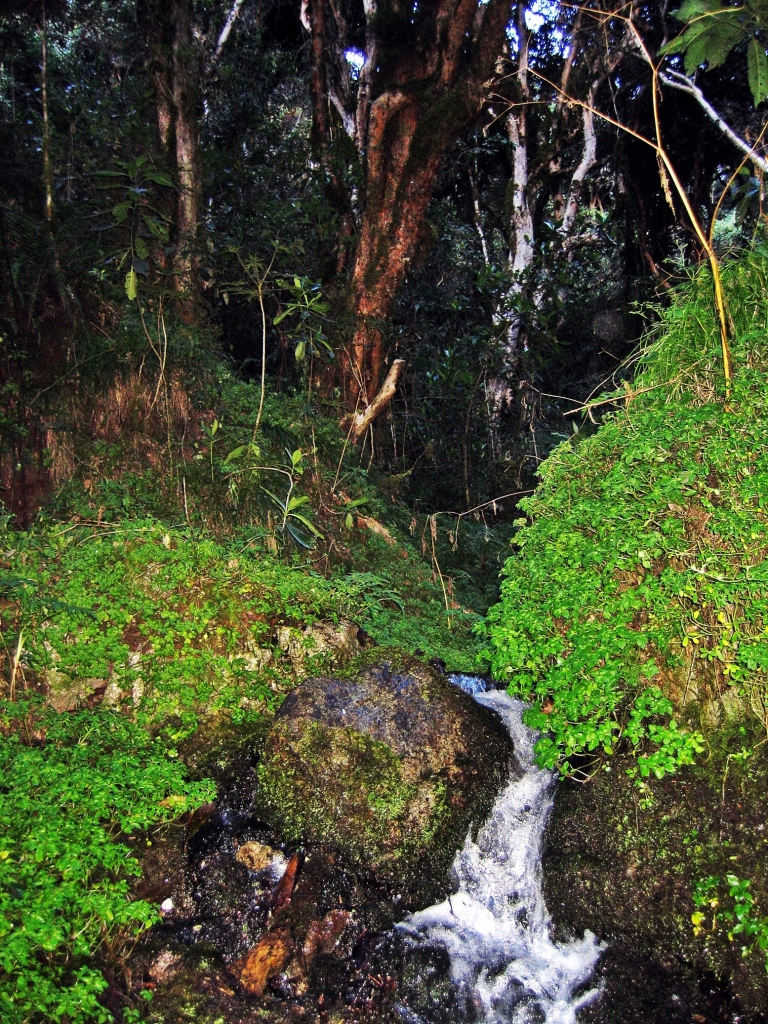
Inca Trail 
Passion flower, Inca Trail 
Inca stone steps, Inca Trail 
Yellow Orchid, Inca Trail 
Bamboo, Inca Trail 
Flower, Inca Trail
Climbing up to the passes, the landscape changed to a more dry, alpine tundra. The slopes were covered in small bushes, straw grass and bromeliads with their tall centre stalk. With the open landscape we could see our objective far ahead. Warmiwañusca, translates to Dead Woman’s Pass, and is the highest that this hike will take us at 4,215 m. This pass received its name because, when seen from below, its crests resemble the form of a woman’s body. Our guide joked though, saying its name is because it is so difficult that a woman died while hiking up the pass. It’s not that difficult, just keep an easy tempo and you’ll get to the top.
From the pass we had great views of a snowcapped Apu Salkantay. Apu is the Inca’s mountain god and also refers to a sacred mountain. After a rest at the pass we had a steep descent into the Pacaymayo Valley (3600 m) where we were back into the forest.
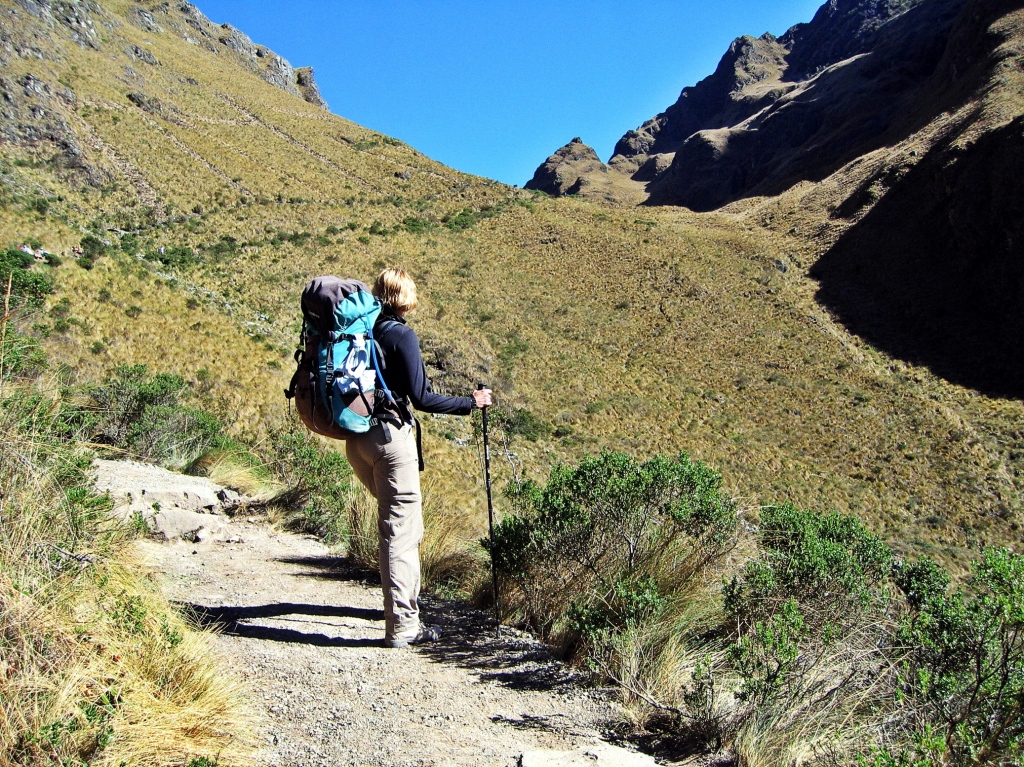
Below Dead Woman’s Pass, Inca Trail 
Bromeliads below Dead Woman’s Pass, Inca Trail 
View of Apu Salkantay from Dead Woman’s Pass, Inca Trail 
View from Dead Woman’s Pass, Inca Trail 
Heading down from Dead Woman’s Pass, Inca Trail
We climbed again, up to the second pass of the day and were back into alpine tundra. Runcuracay Pass (3970 m) is a broad, open pass. From it we had a fantastic view of Dead Woman’s Pass on the other side of the valley. There was a lot of climbing down and then up between these two passes.
Our campsite (3600 m) that night was on a ridge overlooking Sayacmarca, an Inca ruin on the other side of the valley. Some groups visit this ruin, but our guides had a different, less busy site for us to see the next day.

View of Dead Woman’s Pass from Runcuracay Pass, Inca Trail 
Bromeliad in front of Dead Woman’s Pass from Runcuracay Pass, Inca Trail 
Inca Trail 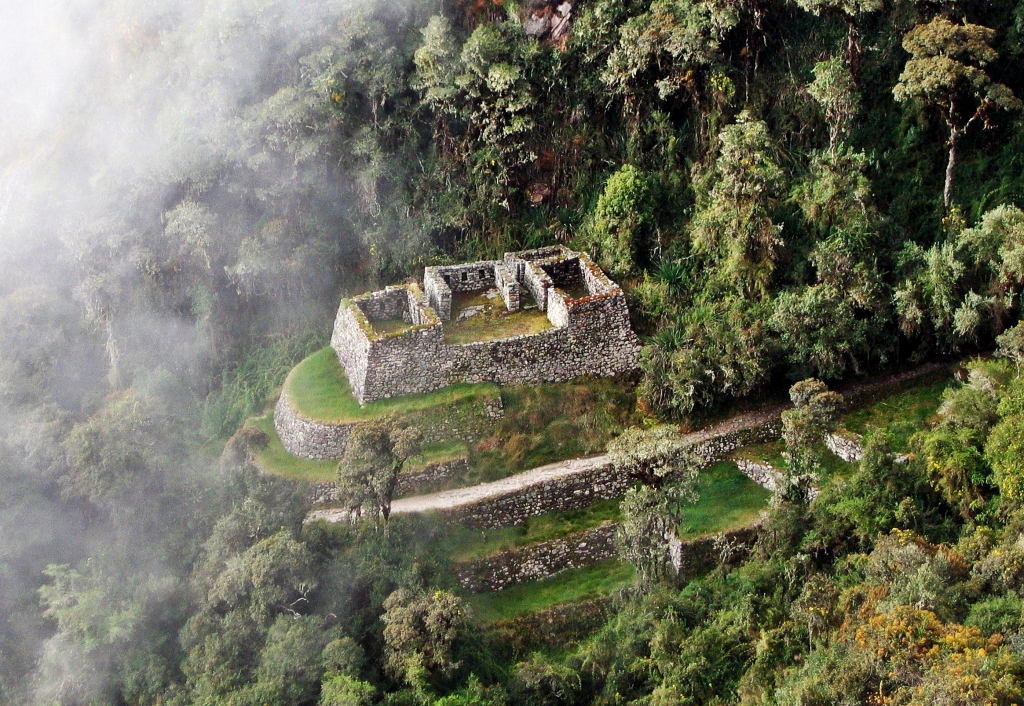
Inca ruins, Inca Trail 
Inca Trail 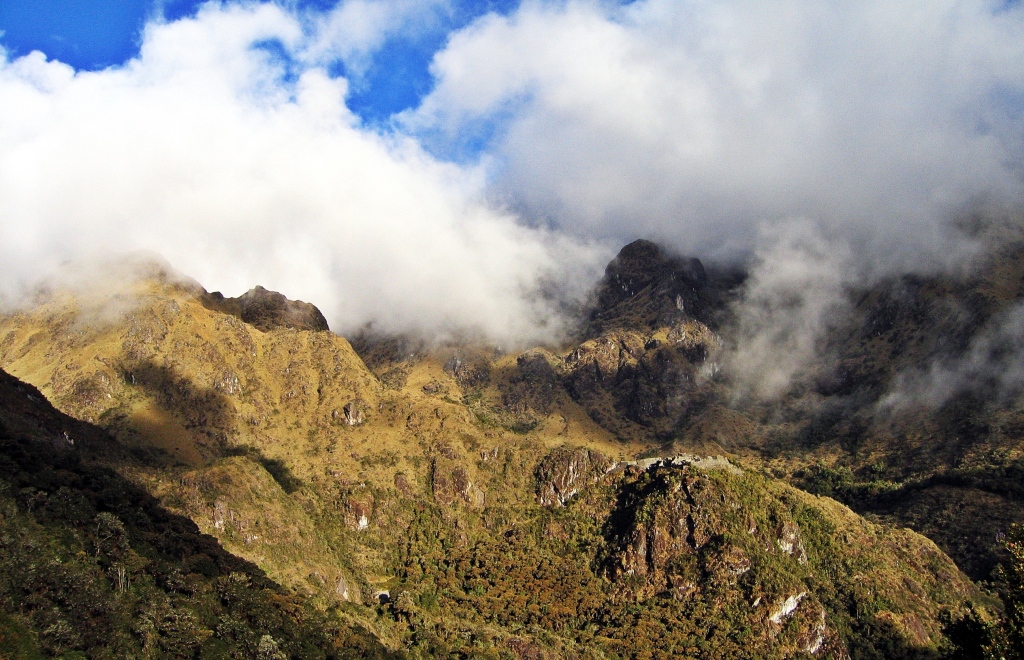
Sayacmarca ruins, Inca Trail 
Sayacmarca ruins, Inca Trail
Day 3 – 115 m ascent, 900 m descent, 5 -6 hours
The previous day was all about climbing, today was all about the descent and returning into the dense forest. Twisted queuña and bamboo almost took over the trail. There are two tight tunnels to pass through. They are natural formations, but the Inca carved them to be large enough to walk through. It’s incredible to think they used only simple tools to create these tunnels.
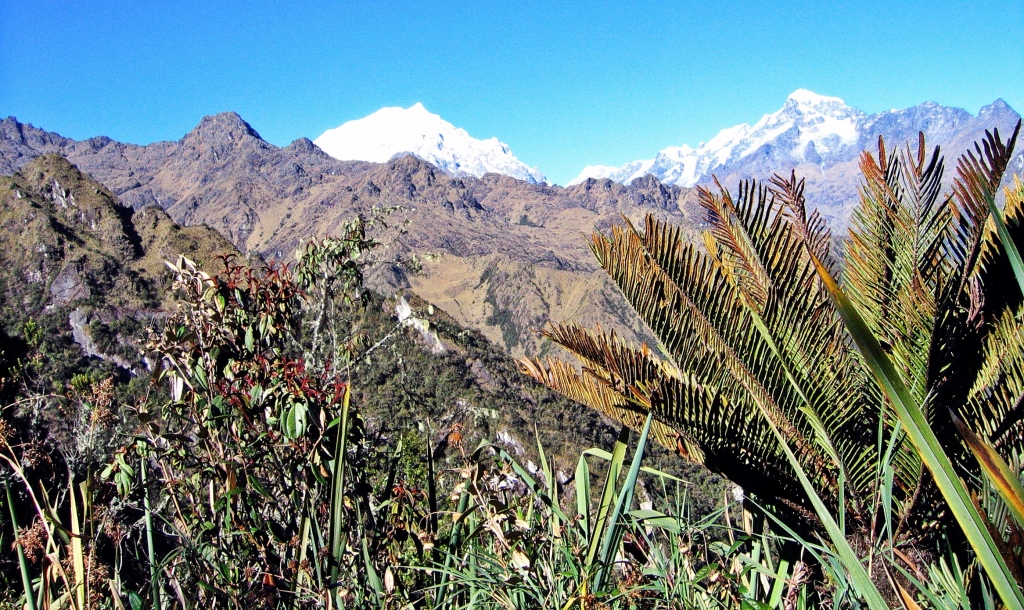
Inca trail 
Queuña trees, Inca Trail 
Stone path, Inca Trail 
Inca tunnel, Inca Trail
We passed by the ruins of Phuyupatamarca (the Town Above the Clouds). Out of the structures remaining are 5 stone baths which were believed to have been used for rituals. After visiting these ruins, we descended a knee-jarring 2,000 stone steps to Wiñaywayna campsite (2,700 m).

Phuyupatamarca ruins, Inca trail 
Phuyupatamarca ruins, Inca trail 
Stone steps, Inca trail
Near camp is one the most beautiful Inca sites we had ever seen. Intipata, ‘The Town of the Sun’, was our favourite spot on the trek so far. It has a fairy-tale like setting with white stone ruins atop tall, steep terraces surrounded by a green jungle. Only our small group was visiting Intipata, so it felt as peaceful as it looks.
On the hike between our camp and Intipati we saw one of the most gorgeous orchids. The Quechua call it Waqanki or ‘Divine Goddess’. There are over 372 varieties of orchids on this trek, this is one of the most beautiful.
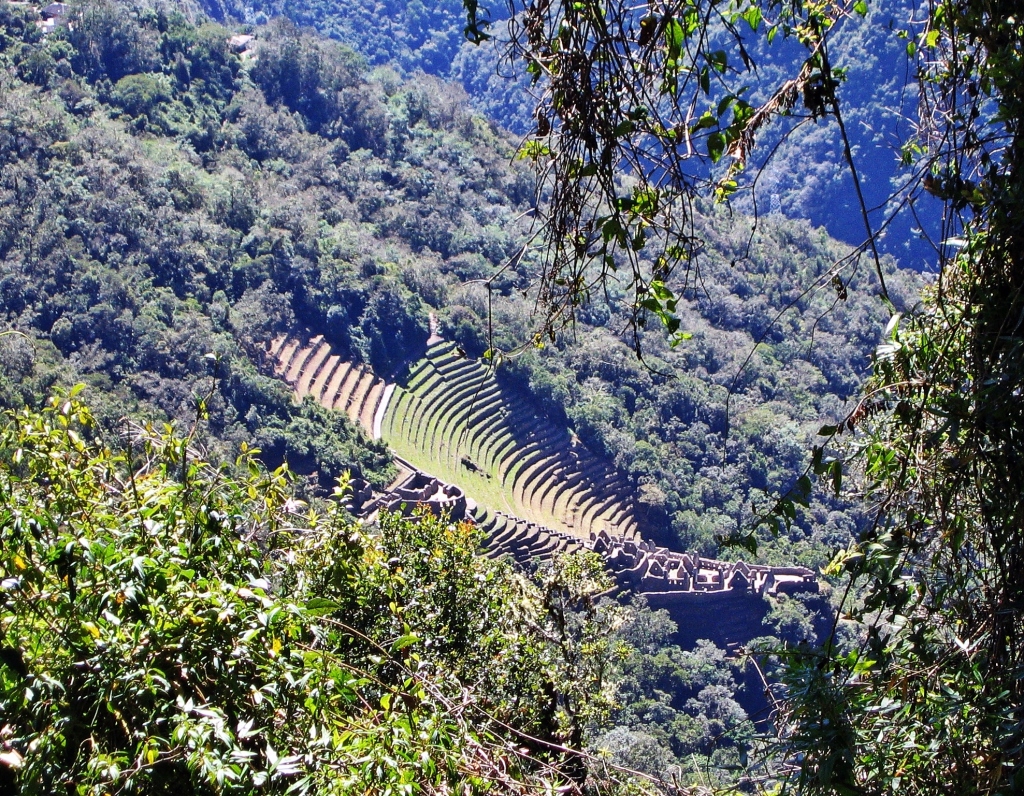
Intipata ruins, Inca trail 
Intipata ruins, Inca trail 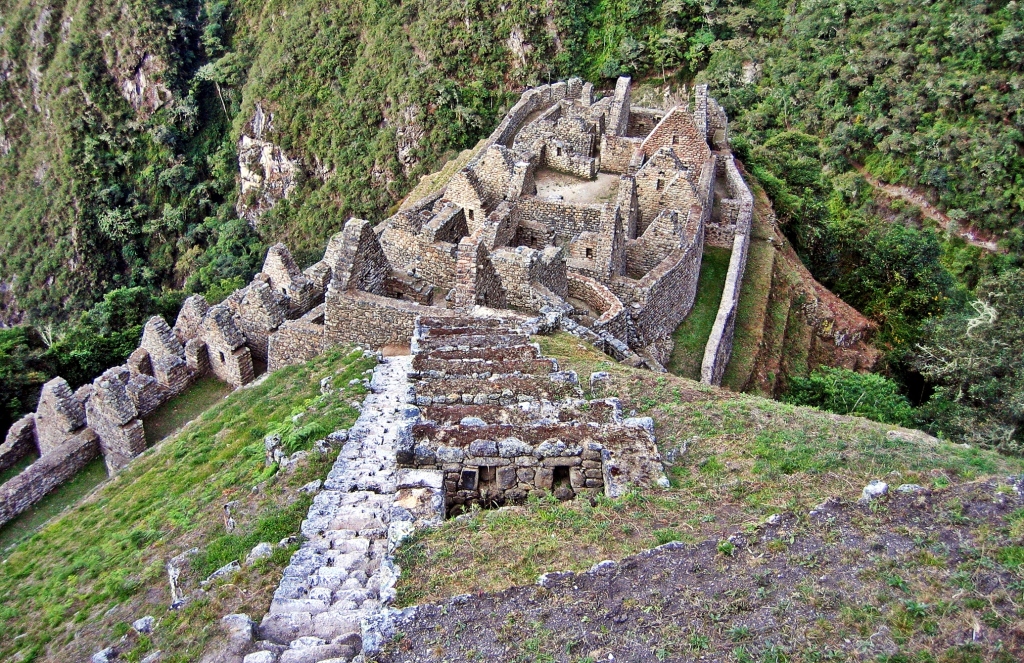
Intipata ruins, Inca trail 
Divine Goddess Orchid, Inca trail 
Sunset, Inca trail
Day 4 – 100 m ascent, 300 m descent, 1 – 2 hrs
The Inca Trail is a very popular hike. The government has limited it to 500 people per day, the majority of those are on the same 4 day trail that we took. Having said that, there are enough campsites for the first two nights that it did not feel too crowded. There were many sections of the trail where we didn’t see any other trekkers. The last night however, all of those people stay at the same camp and try to leave for Machu Picchu at the same time the next morning. It was dark and crowded on a narrow trail with sharp drop offs. Hiking courtesy seemed to have gone out the window. After the first 30 minutes though, the crowd began to separate and the hike was much more enjoyable.
Finally, we arrived at the Sun Gate. And then we see it. Machu Picchu really does take your breath away. It is perfectly situated on the top of a col between Machu and Huayna Picchus, surrounded by tall rocky Andean peaks. It’s an awesome sight. From the Sun Gate we saw it come to life as the first rays of the sun shone on Machu Picchu. The site doesn’t open until 8 am, so we are able to enjoy the view with no one yet on the site.

Machu Picchu during sunrise, Inca trail 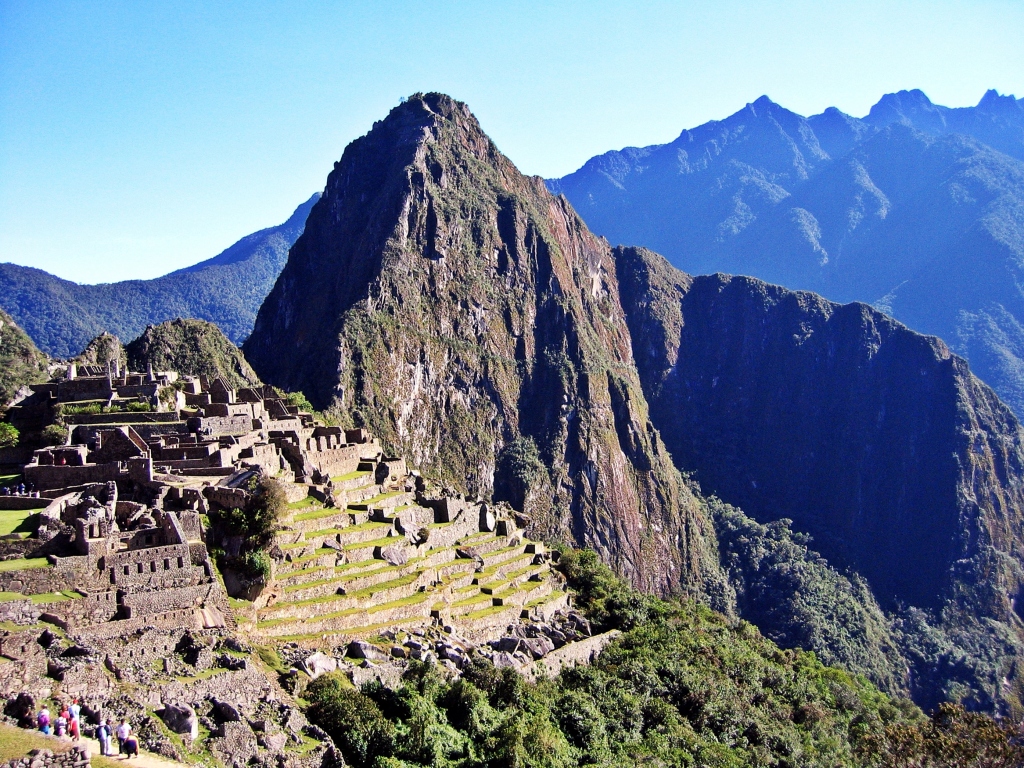
Machu Picchu during sunrise, Inca trail 
Machu Picchu
Built in the 1400s, Machu Picchu (2,430 m) is believed to have been a royal retreat or a sacred religious site for Inca leaders. What’s remaining are stone walkways with thousands of steps that connect plazas, a temple and over 200 buildings. Archaeologists believe it has distinct sectors that including a farming zone, a residential neighborhood, a royal district and a sacred area.

Huayna Picchu 
Mountain Caracara, Machu Picchu 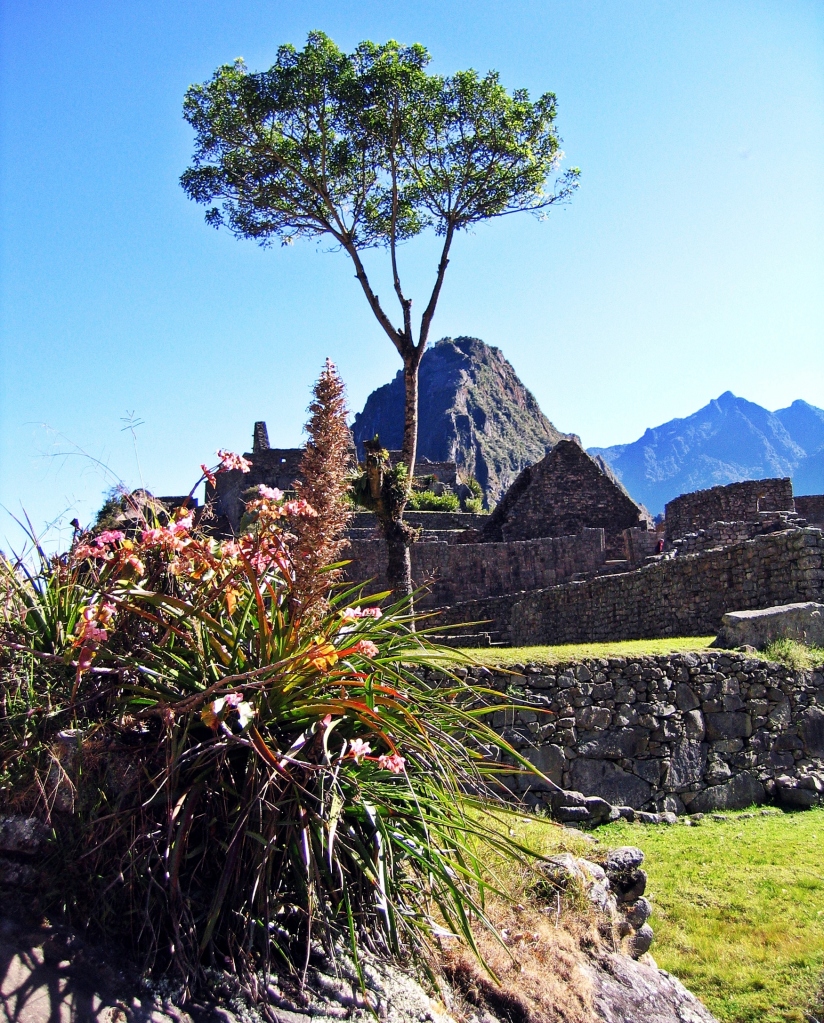
Huayna Picchu behind Machu Picchu
Not only is it an incredible view from above, there are also many individual components to Machu Picchu that make it even more impressive. Many of the Inca steps and walkways are still standing. The walls of buildings are intact having only lost their thatched roofs. In between the top and bottom of the city are impressive crop terraces with complex systems for irrigation.

Machu Picchu, Inca trail 
Terraces and a recreated building, Machu Picchu 
Llama in courtyard, Machu Picchu 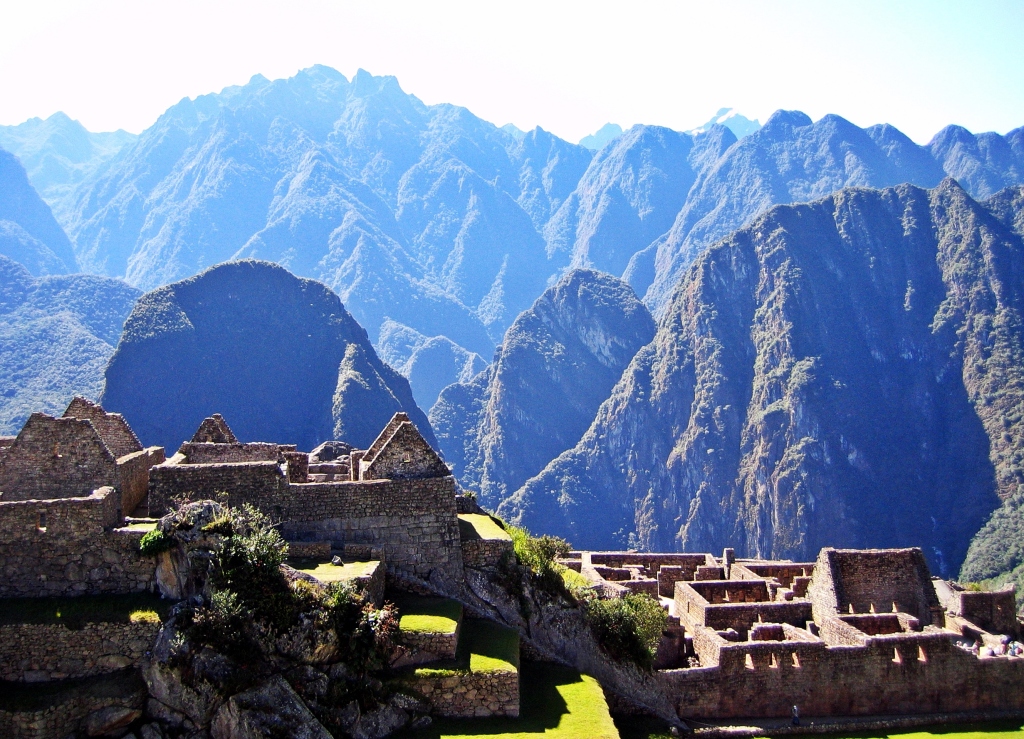
Buildings, Machu Picchu 
Doorway, Machu Picchu
The Inca’s worshiped the sun god (Inti) and the earth goddess (Pachamama). There are many examples of their devotion in the citadel. Stones were carved to match the surrounding mountain landscape. They built a sundial so that the sun would shine on it during the equinox when it precisely rose between two mountain peaks. There are endless places to look and explore.

Carved stone to match Yanantin Mountain in the background, Machu Picchu 
Carved stone to match mountains, Machu Picchu
We also climbed to the top of Huayana Picchu (Young Peak) (2,693 m) for another look at the Machu Picchu (Old Peak) from above. It’s a pretty steep hike with 360 m elevation gain and a few exposed areas. There are more ruins on the top of Huayana Picchu. It’s staggering to think how they managed to carry stones and supplies to the top.
The view from the peak is why we climbed up here. We had a bird’s eye view of Machu Picchu. You can see that it was built in the shape of a condor, an important symbol to the Inca.

Ruins on Huayna Picchu 
Machu Piccchu seen from Huayna Picchu
To get down from Machu Picchu there is a long winding road with dozens of sharp switchbacks and 390 m of descent. Thankfully our guiding company arranged for us to take a bus. We watched in amazement from our comfortable seats as kids ran between each switchback to sell drinks and snacks to bus passengers.
Aguas Calientes is a small tourist town at the base of Machu Picchu. There are restaurants, hotels and hot springs. Many spend a night in town before or after their visit to Machu Picchu. A statue of the 9th Inca king, Pachacutec, stands in the town. He was considered to be the builder of the great Inca Empire.

Statue of Pachacutec, Aguas Calientes
Trek details
The multi day Classic Inca Trail is not difficult, but it is at a high elevation. You reach the highest point on the trail (4,215 m) on the second day so you must be acclimatized before beginning the trek. Spending 3 days in Cusco at 3,400 m will help in acclimatizing. There is a limit of 500 people per day on the trek and this includes staff therefore you usually need to book months in advance.
The dry season is between May and October and peak season is in July and August. The rainy season runs from November to April. The trail is closed for the month of February every year. We did the trek in June and the weather was cool but dry.
You must take a guide to do the trek and there are many agencies in Cusco to choose from. The agencies provide guides, tents, food and for an extra fee you can hire a porter for your backpack. We used SAS Travel and were pleased with their staff, equipment and generous amounts of healthy food.
Climbing Huayana Picchu
Access to Huayana Picchu is limited so you need to book well in advance. Tickets should be purchased when you book your trek. The 260 metres climb itself takes about an hour and is often on steep, exposed stairs.
An alternative is to hike the higher, but less steep Cerro Machu Picchu (3,082 m). A permit is also required and should be purchased well in advance.
Getting to Machu Picchu
If you don’t want to trek, there other options to get to Machu Picchu. Many day tours are offered in Cusco. You can go on your own, by bus or train from Cusco to Aguas Calientes, then walk up the steep hill (around 2 hours) or take a shuttle bus. These shuttles are very busy during peak season.
Entry to Machu Picchu
Tickets to Machu Picchu will be included in your trekking fee, but if you don’t trek you must purchase your entrance ticket in Cusco or Aguas Calientes. Tickets are not sold at the entrance. You must show your passport. They will even stamp it.
A guide is required to enter the site. We’ve heard it is easier and cheaper to use a tour agency in Cusco rather than hiring a guide on site.
There are many rules as to what is allowed on the site. Don’t bring things such as backpacks, drones, hiking poles or food. Storage is available at the entrance gate. Check with the park for the latest regulations.
Coming Next: Touring Poor Man’s Galapagos and the Ancient Nazca Lines
For extra pictures from Peru click here. For pictures from other blogs go to Gallery at monkeystale.ca
To read about more of our adventures go to Destinations.
If you like what you read, please comment or share (with credit) using the links below.
Fantastic!! There are very few posts that awaken that green eyed monster but you often find a way to tug at him and this is no exception!! Wonderful! Thank you for sharing this adventure with us. PS. I hope it’s no my computer but I see little “arrow blocs: on the left of the text which I guess are meant to be photos? Stay Well.!
LikeLike
Arrows now replaced by wonderful photos!! 😉
LikeLiked by 1 person
Oh great I was worried!! Thanks for letting me know!!
LikeLiked by 1 person
You are most welcome 🙂
LikeLiked by 1 person
Great blog and photos. Brings back a lot of great memories of when we tackled the Inca trail too!
LikeLiked by 1 person
Thank you, isn’t it a great area? Glad we brought back those memories.
LikeLike
Fabulous area. You did!
LikeLike
Wonderful experience. We have yet to go to Peru but one day we hope to do it. Thanks for the virtual tour. (Suzanne)
LikeLiked by 1 person
Thank you Suzanne, we love Peru. I hope you get to go one day. Maggie
LikeLike
Fabulous post. Thanks for sharing. My son and his wife were not quite as lucky with the weather on their trek. Stay well. Allan
LikeLiked by 1 person
Thanks Allan, too bad for your son and his wife. We certainly lucked out on the weather on this trek. Although, I do love the pictures of Machu Picchu wrapped in clouds.
LikeLiked by 1 person
Great post 😁
LikeLiked by 1 person
Thank you!
LikeLike
What a wonderful virtual tour of Machu Pichu. It is on my list for sure. Thank you for sharing!
LikeLiked by 1 person
Thank you, it’s one of those places where you hope it’s even half as good as you imagine, and then it’s even better. I hope you are able to see it one day. Maggie
LikeLiked by 1 person
As always, what a fantastic account of a memorable journey! So lovely and lively pictures
LikeLiked by 1 person
Thank you so much! It’s an easy place to fall in love with.
LikeLike
An incredible part of the world. That, of course, is a huge understatement.
Neil S.
LikeLiked by 1 person
haha, yes, we love almost everything about Peru.
LikeLiked by 1 person
Sounds amazing – hope to get there some day – not sure about the hike though… might have to skip that part. Great report – thank you. XXMarie
LikeLiked by 1 person
Thank Marie, the best part of the hike is arriving above Machu Picchu before it’s open. There is a one day option…
LikeLike
This is a very nice post, I had never seen such precise pictures of Ollantaytambo, Llactapata or Intipata. Also I appreciate the pictures of flowers on the way, it is often ignored due to the desire to move forward or tiredness.To better enjoy Machu Picchu, I spent two full days on site, to better immerse myself in the details, the passageways between the districts, a bit like in a real city. The second day allowed me to concentrate on what is best, waiting for the best light and less people. Thank you for sharing.
LikeLiked by 2 people
Thank you so much, we tried to enjoy the journey as much as the destination. I wish we had more time to explore the citadel itself like you did. That’s a great idea.
LikeLiked by 1 person
Another great post folks. We did the trail in October 2018 with Alpaca Expeditions and it was and the tour company fantastic. We spent 3 nights in Ollytambo to explore that city and the rest of the Sacred Vally. We are glad we spend 3 nights. A lot of your photos are the same ones we took. The Inca Trail and Machu Picchu are an amazing experience. Cheers!
LikeLiked by 2 people
In hind sight we should have stayed in Ollantaytambo longer too, but glad we did go on a separate trip. We absolutely loved the trek, seeing so many ruins on the way to Machu Picchu made it very special. And all of the gorgeous flowers were a real treat. Thanks for reading, Maggie
LikeLike
Is there anything more exciting than seeing the Machu Picchu in person? The Inca trail is one of the most iconic treks in South America and for me personally it would be the only way to reach it. It would be an unforgettable experience to walk through lush green cloud forest alive with animals and birds. Thanks for sharing yet another amazing blog post and have a good day 😀 Aiva
LikeLiked by 2 people
Thank you Aiva, even though the trails were busy, I would still recommend to do this trek. There is so much to see on the way, and arriving above Machu Picchu was the best view.
LikeLiked by 1 person
This brings back memories of our own trip to Peru in 2019. What a great place to visit! We did visit Machu Picchu, but did not hike the Inca Trail.
LikeLiked by 1 person
Spectacular images! The way you document your journneys I almost feel like I was there!
LikeLiked by 1 person
Thank you Rob!
LikeLike
Amazing scenery along the trail! We also have sweet memories of the area, even though we did not hike the trail😀 We were not required a guide at the MP entrance, and we bought the tickets online from their official site – it was cheaper LOL Beautiful flowers, I simply love them!! I was amazed how many species of orchids they have..
LikeLiked by 2 people
Maybe their regulations have changed. Since we did the hike we had only heard about the guide requirement, but maybe it has changed or their not strict about it. Good to know, I’ll modify my information. It is a spectacular place though isn’t it?
LikeLiked by 1 person
Oh no, don’t change it, sorry, I didn’t mean that. They do have certain rules, but as long as the people do not take advantage, they are not very strict at the entrance. Same with a little backpack, you can take a snack or something with you inside the site, as long as it is a small one, and you take your own litter back with you. People need to be more aware about preserving this amazing site, it is one of a kind. You can feel recharging your batteries, so much energy in those mountains🙂
LikeLiked by 1 person
Wonderful experience and photos my friends…I think the best way to explore the landscape around Macchu Picchu ❤
LikeLiked by 2 people
Thanks Veronica, yes the hike is the best way since you see so many other ruins and beautiful scenery along the way, and arrive at a great viewpoint over Machu Picchu. I guess some don’t agree, but since you and I love hiking, we agree!
LikeLiked by 1 person
I’m absolutely agree 😍😍😍😍
LikeLike
Fabulous photos – especially of the flowers. And wonderful hike – especially all those birds eye views.
LikeLiked by 2 people
Thanks, The hike had a lot more to offer than we were expecting. There are so many orchids in that area, I’d love to go during rainy season to see more.
LikeLike
I”ve been dreaming of going to Machu Picchu, but I was convinced that I should take the easy way — taking the train and staying in Aguas Calientes. However, after reading this post and looking at your photos, I told myself that the Classic Inca Trail looks to good to miss. Doing this means I need to get in shape months in advance, but those views and the quiet Inca ruins seem to be reason enough to take the hard way.
LikeLiked by 2 people
I think the hike is the best way to arrive. The trek takes you passed other ruins, beautiful scenery, and watching the sunrise on Machu Picchu is very special. As well, I didn’t say this, but our guide is Quechua and taught us a lot about the Inca/Quechua culture. We really appreciated this part of the journey too. The hike isn’t too difficult, a few in our group were not fit, but I think you enjoy the small details more if you’re not suffering. I think you should trek!
LikeLiked by 1 person
You did it the “right” way. We saw some of the same sights on a day trip to Machu Picchu…great memories for us. Wish we could see it this way.
LikeLiked by 2 people
Thanks Michael, the trek is great way to arrive at Machu Picchu. There are so many wonderful views on the way and the history of the area is all around. Thanks for reading!
LikeLiked by 1 person
fantastic detail and amazing picture. Great accoplishment!
LikeLiked by 1 person
Thanks Andy!
LikeLike
Great memories are flooding back for me! We did almost exactly what you did although we did not get up early and arrive at the Sun Gate at sunrise. I don’t remember why now, but we did rise early the next day, and some of our family went back up to the Sun Gate for those views, and some of us climbed Huayna Picchu, one of the freakiest hikes of my life! Eeeeek – glad I did it, though.
I loved the Inca Trail and would do the whole thing all over again.
LikeLiked by 1 person
Probably because you didn’t want to do that narrow trail in the dark with hundreds other people! It is a great hike and I would love to do it again too.
LikeLiked by 1 person
We didn’t do the trail, but we did make it to Machu Picchu. Your pictures bring back good memories (except for the huffing and puffing associated with climbing steep stairs at 8000 feet… 😉 ) I can only imagine climbing Huayana Picchu.
LikeLike
Oh my goodness! I love Peru. This post brought back so many memories. We did Machu Picchu twice because our kids were only 5 the first time we went. They were 13 when we went back and they absolutely loved it.
LikeLiked by 1 person
You did it twice! That’s awesome. I’d love to go again in rainy season. I love the pictures of MP wrapped in clouds.
LikeLike
Well, the first time I went was “The beginning of the end of the rainy season.” No crowds, but man did it rain hard. Not every day or all the time, but when it came down it was pouring. Then the sun came out and dried us off. The second time was high season and dry. We brought all our rain gear but didn’t use it once.
LikeLiked by 1 person
Absolutely stunning photos once again! Such great information for anyone that wants to do this hike…I’m in! haha. I had no idea that there were other sites and things to look at along the way….and wow did you have fabulous weather for the hike! I’ve heard the altitude can be a problem so great advice about spending time in Cuzco before you attempt the trek.
LikeLiked by 1 person
Thank you Linda, the trek is great. There’s a lot more to see on the way than we thought too. Cusco itself is pretty high so even slowly making your way up to it is best but most people don’t have time.
LikeLiked by 1 person
Ah, great memories. 2016, but feels like a million years ago!
Fabrizio
LikeLiked by 1 person
Now a days it really does feel like forever.
LikeLiked by 1 person
Wonderful photos of an amazing experience. I want to do it some day, preferably before my knees get any worse! Your description of the stone steps made me cringe.
LikeLiked by 1 person
They’re hard on the soles of your feet too, walking on such a hard surface for most of each day. But otherwise, it’s worth it! You should do it!
LikeLiked by 1 person
Stunning photography and great information. You make it seem pretty easy, but I’ve heard recounts that make me think it isn’t free from altitude sickness and a gruelling demand.
LikeLiked by 1 person
Thanks, it’s not difficult if you are used to hiking and spend a few days in Cusco to acclimatize. But if you’ve never hiked and arrive straight from sea level it would be near impossible. There were a few in our group who had never hiked, but were in Cusco for 3 or 4 days. They were slow, but loved it and were glad they did it. I think it would be more difficult to take the train and then try to walk up to the top of the site without acclimatizing.
LikeLike
Beautiful photos, what a hiking experience. We visited MP in 2018, by bus though.
LikeLiked by 1 person
Thank you Amy. We really enjoyed the trek to see other Inca sites and the mountain scenery. And of course, as you know, MP is an amazing place. Thanks for reading!
LikeLiked by 1 person
I am incredibly envious! This trek is so appealing to me…the history, the scenery, the flowers, that amazing morning entry into Machu Picchu…The Intipata ruins are stunning and I love the views from Dead Woman’s Pass (though the name is a bit ominous). I have researched this trek a number of times but for various reasons have not managed to get there. I just told my son this would be make a nice mother-son trip for an upcoming milestone birthday. Thanks for all the detail; always good to have a recommendation for a guiding company.
LikeLiked by 1 person
It was a better experience than we had imagined. We don’t hike in groups, are used to the quiet Canadian trails, and thought it was just an alternate way to get to Machu Picchu. I hate to raise expectations, but the scenery and the ruins on the way made it much better than expected. And if you go into it knowing there are a lot of people, it’s not too bad, except on the last morning. I hope you get to go soon. Our company was really good and we were with a Quechua guide who taught us a lot about the history and the culture. Normally you have to book months in advance, but I’m not sure if they’ll even take bookings now.
LikeLiked by 1 person
Beautiful photos. I love the bird.
LikeLiked by 1 person
Thank you. Our guide said it would result in good luck for us!
LikeLike
Wonderful photos and info. This has never been on my bucket list but it is now!!!!
LikeLiked by 1 person
Machu Picchu is a special place. Even though its busy with tourists, you can still appreciate its history and beauty. Thanks for reading!
LikeLiked by 1 person
I have not been there , but it is on my list to do the 7 wonders of the modern world. I know from looking at your pictures, I will not be disappointed. Thanks for sharing your photos.
LikeLiked by 1 person
You definitely won’t be disappointed. It’s even better in person.
LikeLiked by 1 person
Absolutely stunning photos, and what a brilliant write up! The Inca Trail is a real bucket-list item, and this account has pushed it firmly to the top! It looks incredible. Thanks for sharing!
LikeLiked by 1 person
Thanks, it is very impressive in person and even though there are a lot of tourists, we still appreciated it. Definitely keep it near the top of your list.
LikeLike
Excellent post and pictures, very well documented. I did Machu Picchu as a day trip, hope to do the trail next time!
LikeLiked by 1 person
Thank you, the trek is definitely worth it.
LikeLike
I wish I had the chance to hike the trail when I visited Peru. I only had limited time for the travel so I wasn’t able to do it. Seems fantastic indeed! I just hit follow!
LikeLiked by 1 person
Thanks for the follow! The trek was a great way to experience the Inca’s history in Peru and an awesome way to arrive at Machu Picchu. Maybe on your next trip to Peru!
LikeLiked by 1 person
i am from india. i was amazed to see such beautiful photos of peruvian andes hill views of different ruins and also machu picchu . i am encoding the words as south america is none but LEMURIA lands that moved by continent drift to become south america and hence the language i find is all sanskrit and tamil words combined which we in chennai speak either mixed or seperately. . Any how, just browsing through website, i fell that i have travelled to peru which is my desire in my life to expedite more information about their culture.
LikeLiked by 1 person
Haha I don’t think South America is your lost island but it has some incredible places. Peru is a great country with a lot of different terrain, lovely cultures and friendly people. Hopefully you can go there one day.
LikeLike